Home | Category: Muslim Spain
PEOPLE IN MUSLIM SPAIN
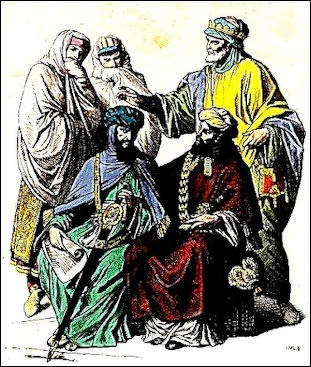
Moors
Cordoba and surrounding Andalusia were a polyglot world inhabited by Moors, Arabs, Jews, Berbers from North Africa, black Africans, Christians, Jews, Mozarabs (Arabized Christians), and traders and mercenaries from Europe.
There were fairly large waves of Arab immigrants to Spain in the early stages but after a while most of the newly arriving Muslims were Berbers. Muslims initially ruled over a non-Muslim majority. Over time many people accepted Islam and some even began speaking Arabic. It is estimated that by the 10th century, majority of the inhabitants in Spain were Muslims. For the most part they lived peacefully with Christians and Jews.
According to the BBC: Islamic Spain was a multi-cultural mix of the people of three great monotheistic religions: Muslims, Christians, and Jews. Although Christians and Jews lived under restrictions, for much of the time the three groups managed to get along together, and to some extent, to benefit from the presence of each other. The Muslim presence in Spain also brought a degree of civilisation to Europe that matched the heights of the Roman Empire and the Italian Renaissance. [Source: BBC, September 4, 2009 |::|]
“Muslim scholars served as a major link in bringing Greek philosophy, of which the Muslims had previously been the main custodians, to Western Europe. There were interchanges and alliances between Muslim and Christian rulers such as the legendary Spanish warrior El-Cid, who fought both against and alongside Muslims.” |::|
Islamic History: Islamic History Resources uga.edu/islam/history ; Internet Islamic History Sourcebook fordham.edu/halsall/islam/islamsbook ; Islamic History friesian.com/islam ; Islamic Civilization cyberistan.org ; Muslim Heritage muslimheritage.com ; Brief history of Islam barkati.net ; Chronological history of Islam barkati.net
Muslims, Jews, Christians and Mozarabs
Cordoba and surrounding Andalusia were a polyglot world inhabited by Moors, Arabs, Jews, Berbers from North Africa, black Africans, Christians, Jews, Mozarabs (Arabized Christians), and traders and mercenaries from Europe. Many Christians in Spain assimilated parts of the Muslim culture. Some learned Arabic, some adopted the same clothes as their rulers (some Christian women even started wearing the veil); some took Arabic names. Christians who did this were known as Mozarabs (literally, Arab-like). |::|
Peaceful relations among Arabs, Berbers, and Spanish converts to Islam were not easily maintained. To hold together such a heterogeneous population, Spanish Islam stressed ethics and legalism. Pressure from the puritanical Berbers also led to crackdowns on Mozarabs and Jews. [Source: Library of Congress *]

Mozarabs
Mozarabs were considered a separate caste even though there were no real differences between them and the converts to Islam except for religion and liability to taxation, which fell heavily on the Christian community. They were essentially urban merchants and artisans. Their church was permitted to exist with few restrictions, but it was prohibited from flourishing. The episcopal and monastic structure remained intact, but teaching was curbed and intellectual initiative was lost. *
In the ninth century, Mozarabs in Cordoba, led by their bishop, invited martyrdom by publicly denouncing the Prophet Muhammad in public. Nevertheless, violence against the Mozarabs was rare until the eleventh century, when the Christian states became a serious threat to the security of Al Andalus. Many Mozarabs fled to the Christian north. *
Muslims and Jews lived together in Muslim Spain in relative harmony. Jews had their own legal system and social services but were relatively powerless. They were required to pay special taxes that Muslims didn't pay, forced to wear identifying clothing and were not allowed to open new synagogues. Jews had a strong sense of alienation and were reminded everyday in numerous ways that they were different. There was also the fear of potent waves of persecution.
Still Jews managed to prosper as craftsmen and traders. They prospered so much in fact that period between 900 and 1200 in Spain and North Africa is known as the Hebrew "golden age," when Jews inspired in part by their Arab counterparts made advances in astronomy, philosophy, science and poetry.
Spanish Muslim Description of Spanish Muslims
Ibn Said wrote in “Book of the Maghrib” in the 13th century: “Such are the words of Ibnu Haukal; but, if truth be told, I am at a loss to guess to whom they are applied. To my countrymen they certainly are not; or, if so, it is a horrible calumny, for if any people on the earth are famous for their courage, their noble qualities, and good habits, it is the Muslims of Andalus; and indeed their readiness to fight the common enemy, their constancy in upholding the holy tenets of their religion, and their endurance of the hardships and privations of war, have become almost proverbial. So, as far as this goes, Ibnu Haukal is decidedly in error, for as the proverb says, "the tongue of stammering is at times more eloquent than the tongue of eloquence." [Source: Ibn Said, “Book of the Maghrib,” in “Ahmed ibm Muhammad al-Makkari, The History of the Muhammadan Dynasties in Spain,” translated by Pascuual de Gayangos s, (London: Oriental Translation Fund, 1840), 1, 95-102. Ibn Said was a 13th century Spanish Muslim writer who describes the richness of Moorish culture of Spain and the divisions within that culture which were to allow the Christian conquest of the areas. =|=]

Mooriish pilgrims returning from Mecca
“As to the other imputation, namely, their being devoid of all senses, wisdom, and talent, either in the field or in administration, would to God that the author's judgment were correct, for then the ambition of the chiefs would not have been raised, and the Muslims would not have turned against each other's breasts and dipped in each other's blood those very weapons which God Almighty put into their hands for the destruction and annihilation of the infidel Christian. But, as it is, we ask-were those Sultans and Khalifs wanting in prudence and talents who governed this country for upwards of five hundred years, and who administered its affairs in the midst of foreign war and civil discord?=|=
“Were those fearless warriors deficient in courage and military science who withstood on the frontiers of the Muslim empire the frightful shock of the innumerable infidel nations who dwell within and out of Andalus, whose extensive territories cover a surface of three months' march, and all of whom ran to arms at a moment's notice to defend the religion of the crucified? And if it be true that at the moment I write the Muslims have been visited by the wrath of heaven, and that the Almighty has sent down defeat and shame to their arms, are we to wonder at it at a time when the Christians, proud of their success, have carried their arms as far as Syria and Mesopotamia, have invaded the districts contiguous to the country which is the meeting place of the Muslims, and the cupola of Islam, committed all sorts of ravages and depredations, and conquered the city of Haleb (Aleppo) and its environs, and done other deeds which are sufficiently declared in the histories of the time?” =|=
Life for Non-Muslims in Islamic Spain
According to the BBC: “Jews and Christians did retain some freedom under Muslim rule, providing they obeyed certain rules. Although these rules would now be considered completely unacceptable, they were not much of a burden by the standards of the time, and in many ways the non-Muslims of Islamic Spain (at least before 1050) were treated better than conquered peoples might have expected during that period of history. 1) they were not forced to live in ghettoes or other special locations; 2) they were not slaves; 3) they were not prevented from following their faith; 4) they were not forced to convert or die under Muslim rule; 5) Jews and Christians were able to contribute to society and culture; 6) they could work in the civil service of the Islamic rulers; and 7) they were not banned from any particular ways of earning a living; they often took on jobs shunned by Muslims. These included unpleasant work such as tanning and butchery; but also pleasant jobs such as banking and dealing in gold and silver. [Source: BBC, September 4, 2009 |::|]
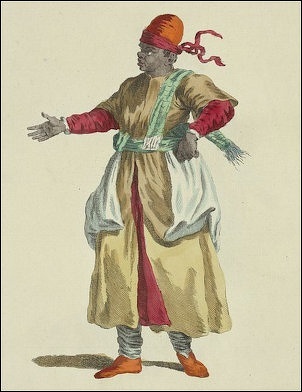
“The alternative view to the Golden Age of Tolerance is that Jews and Christians were severely restricted in Muslim Spain, by being forced to live in a state of 'dhimmitude'.(A dhimmi is a non-Muslim living in an Islamic state who is not a slave, but does not have the same rights as a Muslim living in the same state.) |::|
“In Islamic Spain, Jews and Christians were tolerated if they: 1) acknowledged Islamic superiority; 2) accepted Islamic power; 3) paid a tax called Jizya to the Muslim rulers and sometimes paid higher rates of other taxes; 4) avoided blasphemy; 6) did not try to convert Muslims; 7) complied with the rules laid down by the authorities.
These rules included: 1) restrictions on clothing and the need to wear a special badge; 2) restrictions on building synagogues and churches; 3) they were not allowed to carry weapons; 4) could not receive an inheritance from a Muslim; 5) could not bequeath anything to a Muslim; 6) could not own a Muslim slave; 7) a dhimmi man could not marry a Muslim woman (but the reverse was acceptable); 8) a dhimmi could not give evidence in an Islamic court; 9) dhimmis would get lower compensation than Muslims for the same injury |At times there were restrictions on practicing one's faith too obviously. Bell-ringing or chanting too loudly were frowned on and public processions were restricted. |::|
“The Muslim rulers didn't give their non-Muslim subjects equal status; as Bat Ye'or has stated, the non-Muslims came definitely at the bottom of society. Bat Ye'or wrote in “Islam and Dhimmitude,” “Society was sharply divided along ethnic and religious lines, with the Arab tribes at the top of the hierarchy, followed by the Berbers who were never recognized as equals, despite their Islamization; lower in the scale came the mullawadun converts and, at the very bottom, the dhimmi Christians and Jews.” [Source: Bat Ye'or, Islam and Dhimmitude, 2002]
Muslim View of Non-Muslims in Islamic Spain and Why They Were Tolerated
“The Muslims did not explicitly hate or persecute the non-Muslims. In the “The Jews of Islam,” Bernard Lewis wrote: “In contrast to Christian anti-Semitism, the Muslim attitude toward non-Muslims is one not of hate or fear or envy but simply of contempt.” An example of this contempt is found in this 12th century ruling: “A Muslim must not massage a Jew or a Christian nor throw away his refuse nor clean his latrines. The Jew and the Christian are better fitted for such trades, since they are the trades of those who are vile” |::|

Cordoba menora
Why then were non-Muslims tolerated in Islamic Spain? According to the BBC: “There were several reasons why the Muslim rulers tolerated rival faiths: 1) Judaism and Christianity were monotheistic faiths, so arguably their members were worshipping the same God; 2) despite having some wayward beliefs and practices, such as the failure to accept the significance of Muhammad and the Qur'an; 3) The Christians outnumbered the Muslims; 4) so mass conversion or mass execution was not practical; 5) outlawing or controlling the beliefs of so many people would have been massively expensive; 6) Bringing non-Muslims into government provided the rulers with administrators; 7) who were loyal (because not attached to any of the various Muslim groups); 8) who could be easily disciplined or removed if the need arose. (One Emir went so far as to have a Christian as the head of his bodyguard.); 9) Passages in the Qur'an said that Christians and Jews should be tolerated if they obeyed certain rules. [Source: BBC, September 4, 2009 |::|]
Oppression in Later Islamic Spain
According to the BBC: “Not all the Muslim rulers of Spain were tolerant. Almanzor looted churches and imposed strict restrictions. The position of non-Muslims in Spain deteriorated substantially from the middle of the 11th century as the rulers became more strict and Islam came under greater pressure from outside. Christians were not allowed taller houses than Muslims, could not employ Muslim servants, and had to give way to Muslims on the street. Christians could not display any sign of their faith outside, not even carrying a Bible. There were persecutions and executions. [Source: BBC, September 4, 2009 |::|]
“One notorious event was a pogrom in Granada in 1066, and this was followed by further violence and discrimination as the Islamic empire itself came under pressure. As the Islamic empire declined, and more territory was taken back by Christian rulers, Muslims in Christian areas found themselves facing similar restrictions to those they had formerly imposed on others. |::|
“But, on the whole, the lot of minority faith groups was to become worse after Islam was replaced in Spain by Christianity. There were also cultural alliances, particularly in the architecture - the 12 lions in the court of Alhambra are heralds of Christian influences. The mosque at Cordoba, now converted to a cathedral is still, somewhat ironically, known as La Mezquita or literally, the mosque. The mosque was begun at the end of the 8th century by the Ummayyad prince Abd al Rahman ibn Muawiyah. |::|
“Under the reign of Abd al Rahman III (r. 912-961) Spanish Islam reached its greatest power as, every May, campaigns were launched towards the Christian frontier, this was also the cultural peak of Islamic civilisation in Spain. |::|
Jews in Spain
The decades around A.D. 1000 CE were a golden age for Jews in Spain. Thriving and amicably co-existing with the country’s Islamic rulers, Jews held major positions in the Muslim government and made contributions to science and Hebrew literature and Talmud scholarship. This golden age continued even after an attempt to forcibly convert all Jews to Islam in 1086. CE, [Source: BBC]
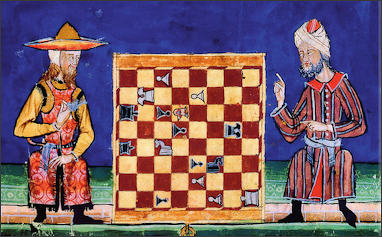
Jew and Muslim playing chess
Jews and the Muslim period of Spain:
711: Muslim Forces Attack Spain Successfully.
712: Jews help Muslim invaders capture Spain, ending Visogoth rule and beginning a 150 year period of relative peace, in which Jews were free to study and practice religion as they wished.
732: Islam repulsed at Tours (France), gateway to Europe.
ca. 760: Karaism founded (Jewish reaction to Rabbinic Judaism).
ca. 950-1150: “Golden Age” in Spain (Islamic Umayyad dynasty).
1027: Samuel Hanagid becomes vizier of Granada. He is the first of the poets of the Golden Age of Spain, and symbolic of both the political power and literary creativity of Jews in Spain at the time.
conditions.
1086-1145: Judah Halevi, the greatest Hebrew poet of his time.
[Source: Fordham University, sourcebooks.fordham.edu]
Jews and the later Muslim and early Christian periods of Spain:
1090: Iban Iashufin, King of the Almoravides, captured Granada and destroyed the Jewish community, the survivors fled to Toledo.
1135-1204: Moses Maimonides, regarded as the greatest Torah scholar,
1321: Henry II of Castile forces Jews to wear yellow badges.
1391: Ferrand Martinez, archdeacon of Ecija, begins a campaign against Spanish Jewry, killing over 10,000 and destroying the Jewish quarter in Barcelona. The campaign quickly spreads throughout Spain, except for Granada, and destroys Jewish communities in Valencia and Palma De Majorca.
1391: King Pedro I orders Spain not to harm the remaining Jews and decrees that synagogues not be converted into churches.
1392: King Pedro I announces his compliance with the Bull of Pope Boniface IX, protecting Jews from baptism. He extends this edict to Spanish Jewish refugees.
Politically-Powerful Jew in 11th Century Spain

14th century Spanish haggadah
Mid 20th century Jewish historian Jacob Marcus wrote: One of the most famous of the Jewish notables of Moslem Spain was Samuel Ha―Levi [born 993, died after 1056] , who is also known as Samuel Ha―Nagid. Beginning life as a shopkeeper, Samuel Ha―Levi ultimately became the chief minister at the court of Granada. By virtue of this office he became the political head of the Jews in Granada and probably thus received the title Nagid ("Prince"), his name becoming Samuel Ha―Nagid. He served his community as rabbi and did a great deal to further Jewish learning throughout the world. Samuel was a fine linguist, a scholar, a diplomat, and a distinguished soldier. His reputation in the Middle Ages was based mainly on his excellent poetry, some of which was written even on the battlefield. The following account of his life is taken from Sefer Seder ha-Kabbalah ("The Line of Tradition"), a Hebrew historical work written by Abraham ibn Daud of Toledo in 1161. [Source: Jacob Marcus, The Jew in the Medieval World: A Sourcebook, 315-1791, (New York: JPS, 1938), 297-300, later printed Atheneum, 1969, 1972, 1978, sourcebooks.fordham.edu] On Samuel Ha-Nagid, Vizier of Granada by by Abraham ibn Daud reads. “One of the great disciples of Rabbi Enoch [d. 1014], was Rabbi Samuel Ha―Levi, the Prince, the son of Joseph, who was known as Ibn Nagrela, of the community of Cordova. He was an unusually fine Talmudic scholar and was also well versed in Arabic literature and language. He was of the type that could occupy a high position in the royal palace.
“Samuel was a merchant, supporting himself with great difficulty until the devastating days in Spain which followed the fall of the Amirid kingdom when the Berbers secured the power. [The civil war, which began in Spain in 1009, reached its climax in 1012 in the sack of Cordova by the Berbers.] It was then that the land of Cordova began to decline and its inhabitants fled. Some of them ran away to Saragossa, where their descendants are even now; some fled to Toledo and their descendants are known there even to this day.
“This Rabbi Samuel Ha―Levi fled to Malaga. There he had a shop and was a petty merchant. His shop happened to be near the palace of Ibn al―Arif, the vizier of King Habbus [1019―1038], the son of Maksan, the King of the Berbers, in Granada. At the request of a maid servant of the vizier, Samuel used to write letters for her to her master the vizier, Abu al―Kasim ibn al―Arif. This latter saw his letters and was amazed at his wisdom.
“Some time later this vizier, Ibn al―Arif, got permission of his king, Habbus, to return to his home in Malaga. There he asked the people of his house: "Who used to write those letters that came to me from you?" "A certain Jew," they answered, "who comes from the community of Cordova and lives near your palace-he used to write them for us." Immediately the secretary issued a command and they rushed Rabbi Samuel Ha―Levi to him. "It is unbecoming for you to sit in a shop," he said to him. "Stay here with me." He did so and became his secretary and adviser.
“The vizier used to advise the King according to the advice given by Rabbi Samuel Ha―Levi, of blessed memory. All his advice was as though it came from God, and the King Habbus prospered through it very much. After some time the vizier, Ibn al―Arif, became mortally ill, and King Habbus, who came to visit him, said to him: "What shall I do? Who will advise me in the wars which encompass me?" "I have never advised you," he answered him, "out of my own mind, but at the suggestion of this Jew, my secretary. Take care of him, and he will be as a father and a minister to you. Do whatever he advises you, and God will help you." So after the death of the vizier, King Habbus took Rabbi Samuel Ha―Levi and brought him to his palace and he became his vizier and councillor.”
Jewish Scholarship and Politics in 11th Century Spain
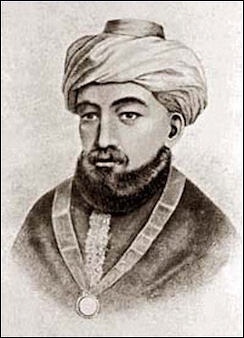
Maimonides, a famous Jewish scholar in Spain
On Samuel Ha-Nagid, Vizier of Granada by Abraham ibn Daud continues: “In the year 4780 [l020] he was in the palace of the King Habbus. [Samuel was already an important official before 1020.] The king had two sons: the name of the elder was Badis, and the younger, Bulukkin. All the Berber princes favored Bulukkin, the younger son, as the successor, but all the rest of the people favored Badis. The Jews, too, and among them Rabbi Joseph ibn Migas, Rabbi Isaac ben Leon, and Rabbi Nehemiah, who was called Escafa, three Granada notables, favored Bulukkin, but Rabbi Samuel Ha―Levi favored Badis. On the day that King Habbus died, the Berber princes and their distinguished men rose in the morning to crown his son Bulukkin. Bulukkin, however, immediately went and kissed the hand of his elder brother Badis. Thus Badis was crowned in the year 4787 [1027] and the face of his enemies turned black like the bottom of a pot; and against their will they had to crown Badis. [Badis was really crowned in 1038 and died in 1073.] [Source: Jacob Marcus, The Jew in the Medieval World: A Sourcebook, 315-1791, (New York: JPS, 1938), 297-300, later printed Atheneum, 1969, 1972, 1978, sourcebooks.fordham.edu]
“After this Bulukkin regretted that he had made his brother king and kept on getting the upper hand over his brother Badis, with the result that King Badis was unable to do a thing, big or small, without his brother's interference. But after this his brother Bulukkin became sick, and the King gave orders to the physician not to cure him. The physician obeyed, and Bulukkin died. Thus was the kingdom established in the hands of Badis. These three distinguished Jews of the city, whom we have mentioned, fled to the land of Seville [then hostile to Granada].
“Rabbi Samuel Ha―Levi was appointed Prince in the year 4787 [1027], and he conferred great benefits on Israel in Spain, in north-eastern and north―central Africa, in the land of Egypt, in Sicily, well as far as the Babylonian academy, and the Holy City, Jerusalem. All the students who lived in those lands benefited by his generosity, for he bought numerous copies of the Holy Scriptures, the Mishnah, and the Talmud-these, too, being holy writings. [Ibn Daud here refutes the Karaites who denied the authority of the Mishnah and the Talmud.]
“To every one-in all the land of Spain and in all the lands that we have mentioned-who wanted to make the study of the Torah his profession, he would give of his money. He had scribes who used to copy Mishnahs and Talmuds, and he would give them as a gift to students, in the academies of Spain or in the lands we have mentioned, who were not able to buy them with their own means. [Printing was not yet invented. Manuscripts were very expensive.] Besides this, he furnished olive oil every year for the lamps of the synagogues in Jerusalem. He spread the knowledge of the Torah [Jewish learning] very widely and died an old man, at a ripe age, after having acquired the four crowns: the crown of the Torah, the crown of high station, the crown of Levitical descent, and what is more than all these, the crown of a good name merited by good deeds. He died in the year 4815 [1055] and his son, Rabbi Joseph Ha―Levi, the Prince, succeeded him. [It is more probable that Samuel died in 1056 or later when Joseph (b. 1035), succeeded him as vizier.]
Muslim Violence against Spanish Jews in the 11th Century
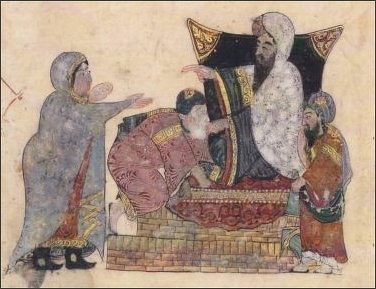
married couple before the qadi
On Samuel Ha-Nagid, Vizier of Granada by Abraham ibn Daud includes an account of first Muslim violence against Spanish Jews. This section of the account reads: “Of all the good traits of his father, Joseph lacked but one. He was not humble like his father because he grew up in riches, and he never had to bear the yoke [of poverty and discipline] in his youth. He was proud to his own hurt, and the Berber princes were jealous of him, with the result that on the Sabbath, on the 9th of Tebet in the year 4827 [Saturday, December 30, 1066], he and the Community of Granada were murdered. [About 150 families were killed. This is the first known massacre of Jews in Spain by Moslems.]
All those who had come from distant lands to see his learning and his greatness mourned for him, and the lament for him spread to all lands and to all cities. Since the days of the ancient rabbis - of blessed memory-who wrote the Scroll of Fasts and decreed that the 9th of Tebet should be a fast, the reason for the decree was never known. But from this incident we know that they were directed by the Holy Spirit to fix this day. After his death his books and treasures were scattered and dispersed throughout the world So also were the disciples whom he had raised up. After his death they became the rabbis of Spain and the leaders of the generation.”
Ordinance of the Jews of the Crown of Aragon, 1345
After the Muslims were driven out of Spain, Jews were persecuted more severely by Christian despite things like the Ordinance of the Jews of the Crown of Aragon. Paul Halsall of Fordham University wrote: “This ordinance or takkanah was the product of an increased sense of Jewish vulnerability in the years after the Black Death (1348). It attempted to draw together Jews from all of the communities of the Crown of Aragon to address shared problems, and propose collective solutions to them. The Crown of Aragon was a group of associated realms, governed separately by the same ruler: Catalonia, and the kingdoms of Aragon, Valencia and Majorca. The assembly which produced the ordinance was not entirely successful: it was attended only by delegates of Catalonia and Valencia (see below), and it failed to create an ongoing institutional framework for intercommunal efforts. It nonetheless provides important testimony of the problems perceived by Jews in the 1350s and the sorts of solutions which they envisioned, as well as the potential difficulties which they faced. [Source: sourcebooks.fordham.edu]
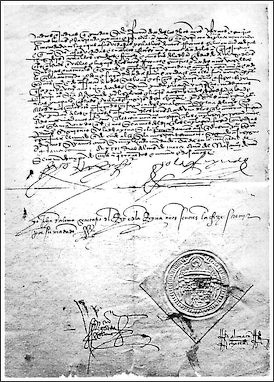
Alhambra decree
Louis Finkelstein, the editor of the text, wrote: “The introduction recites the woes that have befallen the Jewish people. "Many of faint heart, weak by nature" seeing the implements of torture were unable to withstand the trial and yielded their faith, "crossing over the bridge in their distress". Apparently some of them turned against their former brethren, "bending their bow, making ready their arrow" to shoot by their deadly defamations whomever they pleased. The people of Israel have thus come into hard times. Unless immediate action be taken danger would result to the whole community. It was their duty to take counsel and to save themselves and theirs before the evil fell. Already there were cases of murder and riot here and there, and no effective protest had been raised. If "the communities were made into a single union with a common treasury" they would be in a position to defend themselves, and to bring punishment on such as attacked them. Of what value would their money be to them if there lives were in danger? Since there was no leader taking upon himself the duty of protecting "the sheep of the Lord", the delegates has (sic) assembled at the call of the Jewish Community of Barcelona to take counsel in the critical situation. [Source: Louis Finkelstein, Jewish Self-government in the Middle Ages (New York: Jewish Theological Seminary of America, 1924), pp. 336-47]
“It was evident that the matter could not be left to the individual communities to deal with separately, as singly they were far too weak for the task. The only means for saving themselves in the situation was to use their money power, and they feared that "if one community will not help the other, we will be unable to bring the money which is annually assessed against us to the treasury of the King" and that "we will appear ungrateful" in his eyes and the eyes of the princes. It was therefore necessary to perfect an organization which should be responsible for the funds. A commission would be appointed to wait on the King [Peter IV, 1336-87] in order to secure his assent to the formation of the union and the ordinance which were enacted by the council. The commission was to hold office for five years.”
Image Sources: Wikimedia Commons
Text Sources: Internet Islamic History Sourcebook: sourcebooks.fordham.edu “World Religions” edited by Geoffrey Parrinder (Facts on File Publications, New York); “ Arab News, Jeddah; “Islam, a Short History” by Karen Armstrong; “A History of the Arab Peoples” by Albert Hourani (Faber and Faber, 1991); “Encyclopedia of the World Cultures” edited by David Levinson (G.K. Hall & Company, New York, 1994). “Encyclopedia of the World’s Religions” edited by R.C. Zaehner (Barnes & Noble Books, 1959); Metropolitan Museum of Art, National Geographic, BBC, New York Times, Washington Post, Los Angeles Times, Smithsonian magazine, The Guardian, BBC, Al Jazeera, Times of London, The New Yorker, Time, Newsweek, Reuters, Associated Press, AFP, Lonely Planet Guides, Library of Congress, Compton’s Encyclopedia and various books and other publications.
Last updated September 2018
